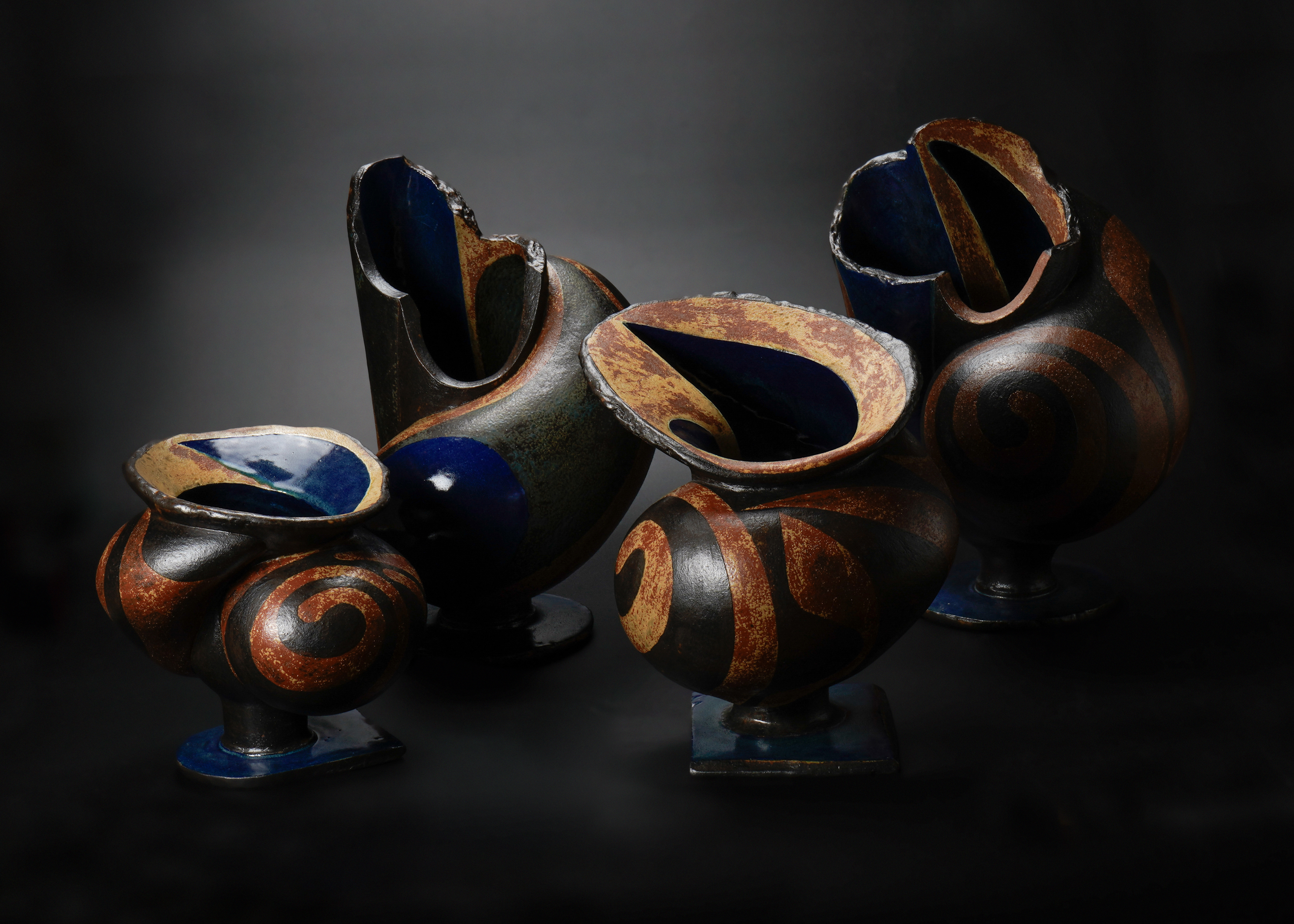
13 minute read
Yanagihara Mutsuo: A Life for Play and Form
In 2024, a legend turned 90: Yanagihara Mutsuo. For nearly 60 years, Yanagihara has been at the forefront of ceramics in Japan, pursuing a distinctive and instantly recognizable style. Deeply committed to originality in both concept and form, he develops decorative, flowing themes and crafts complex, organic shapes by intricately weaving together a sophisticated system of curves. His ceramics seamlessly blend surface pattern with form, showcasing a harmonious union.
I had the honor of visiting the retired Osaka University of Arts professor at his home on the outskirts of Kyoto. Sitting in his living room, surrounded by dozens of his colorful vessels, he casually introduced himself—“I’m Mutsuo”—and apologized that his English was not as strong as it had been decades ago, when he lived in the United States. However, the lengthy monologue that followed demonstrated that his command of the English language remained undiminished.
Between 1966 and 1982, Yanagihara received grants and appointments that allowed him to live in the U.S. three times, each for nearly two years. In 1966, a Fulbright grant enabled him to teach ceramics at the University of Washington in Seattle. He returned in 1972 as an Assistant Professor at Alfred University in New York State, and later taught at Scripps College in Claremont, California. His third “tour” began in 1980 with a fellowship from the National Endowment for the Arts, which supported his lecturing and teaching of ceramics at various institutions.
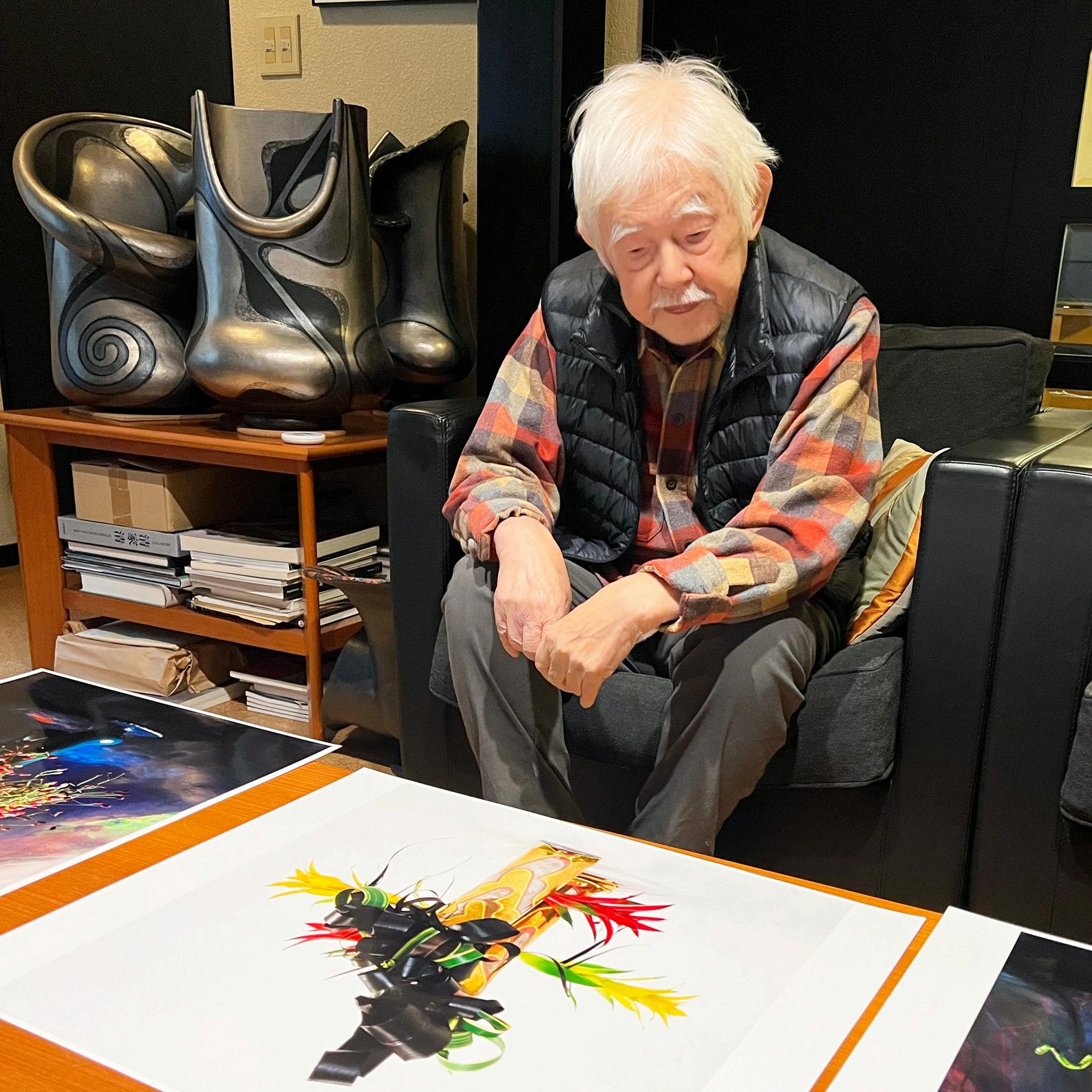

Few Japanese artists or educators have had such extensive first-hand experience in the United States. While Yanagihara was influenced by the American Pop Art movement he encountered there, he also developed a distinctive style of his own, independent of those influences.
Yanagihara was born in 1934 in the city of Uwajima, Ehime Prefecture, on the scenic island of Shikoku, into a family of medical doctors. His grandfather was an internist, and his father an otolaryngologist. When Yanagihara was three years old, his parents moved 80 miles (130 km) east to Kōchi City. His upbringing on the Pacific coast of Shikoku—the smallest of Japan’s major islands, known for its rich vegetation—and in a well-educated family fostered in Yanagihara an early appreciation for both botany and the human body, themes that are later expressed in his ceramics.
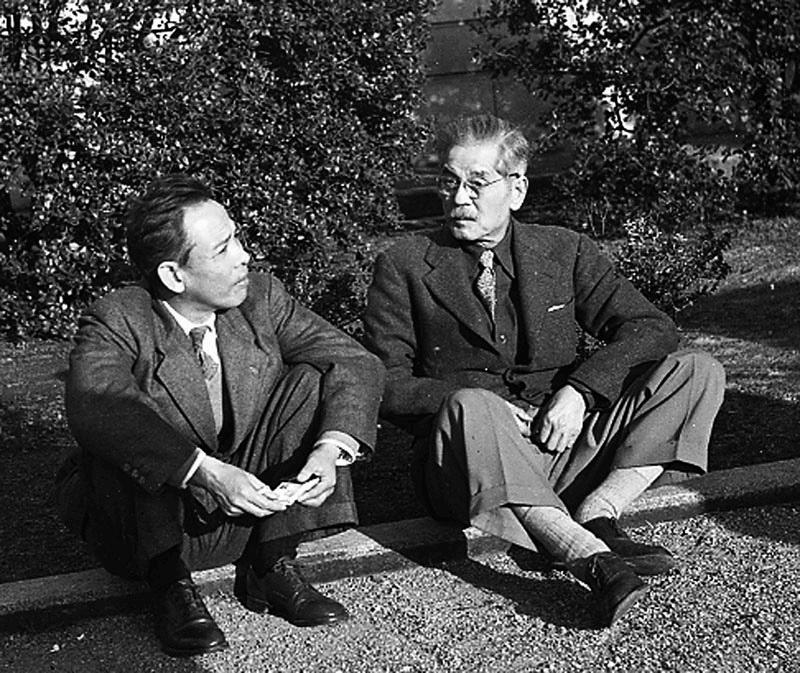
In 1954, he moved to Kyoto and entered the Department of Crafts at Kyoto City University of Arts to study ceramics. Coincidentally, this was a watershed moment in the long history of Japanese ceramics, marked by the emergence of an avant-garde movement. Yanagihara’s teachers were three important figures in modern ceramics: Tomimoto Kenkichi (1886–1963), Kondō Yūzō (1902–1985), and Fujimoto Yoshimichi (1919–1992). Tomimoto, the founder of the department, is now regarded as Japan’s most influential ceramic artist of the 20th century. Kondō, who later became the university’s president, is known for his modernist approach to classic blue-and-white porcelain (sometsuke). Fujimoto, renowned for depicting natural motifs in overglaze enamels, also joined the avant-garde group Sōdeisha (literally translated as the "Crawling through Mud Association") in 1957, remaining a member for several years.
Tomimoto in particular, for whom Yanagihara served as a teaching assistant after graduating in 1960, had a significant impact on Yanagihara. In 1959, before graduating, the young Yanagihara achieved his first success as an artist when he received the Association Prize at the ninth annual exhibition of the Modern Art Association. The exhibition was displayed at four prestigious venues: Tokyo Metropolitan Art Museum, Kyoto City KYOCERA Museum of Art (then the Kyoto Municipal Museum of Art), Osaka City Museum of Fine Arts, and Kochi Daimaru. This was only the second time Yanagihara had participated in the exhibition, and he was not admitted into the association as a member until 1962.
The winning artwork was an abstract sculpture in vessel form, standing two feet (62 cm) tall, titled Appearance (Bō 貌, 1959), which is now in the collection of The Museum of Art, Kōchi. Already apparent in this piece—and in other works from the late 1950s and early 1960s—is Yanagihara’s enjoyment of experimenting with form. He clearly strove to create shapes that no one had made before him. These early works were initially monochromatic—mostly in brown and green—and worlds apart from the bright palette that would later become his signature. His surface treatments are asymmetrical, often divided between smooth planes and rough edges.

While his forms from the first half of the 1960s are sculptural, they still retain a sense of functionality, even if only in theory. This is demonstrated in two works titled Pigeon Nest (Hato no su 鳩の巣), now in the collection of the Museum of Modern Art, Wakayama. Absorbing Green I (Kyūchaku suru midori I 吸着する緑Ⅰ), housed in the Hiroshima Prefectural Art Museum, could even function as a flower vase.
Once Yanagihara reached the United States in 1966, he expanded his range of shape and decoration to tubular forms that have an organic feel, while adding striped decoration in brightly colored glazes to the otherwise muted surface. During his time, as visiting professor of ceramics at the University of Washington, Yanagihara was accepted to local group exhibitions and even won an award. At the Northwest Craftsmen’s Exhibition in 1967 (Nov. 21–Dec. 24) held at the Northwest Museum of Arts & Culture (then called the Cheney Cowles Memorial Museum) in Spokane, WA, he was one of twelve winners from a pool of 245 participants. In 1968, Museum West in San Diego, CA, organized a two-person exhibition (May 17–Jun. 23) that juxtaposed the complex textile weavings of Colombian artist Olga de Amaral (born 1932) with Yanagihara’s much more minimal ceramics.

After returning to Japan in 1968, Yanagihara became an assistant professor of ceramics at Osaka University of the Arts. In 1970, Yanagihara began creating many series of sculptures that shared distinctive forms and patterns that he would pursue for a few years before moving onto the next. This cycle would continue for the next 50 years. The first series comprises dark blue glazed vessels with a white dot pattern accented with gold and silver luster overglaze (kon’yū kingin-sai 紺釉金銀彩). The vessels are mostly flower vases, the most acclaimed of which resemble a flower bud. Yanagihara submitted one of the vases from this series to the prestigious 29th International Competition of Contemporary Art Ceramics in Faenza, Italy in 1971 and was awarded the Ravenna City Chamber of Commerce Prize.
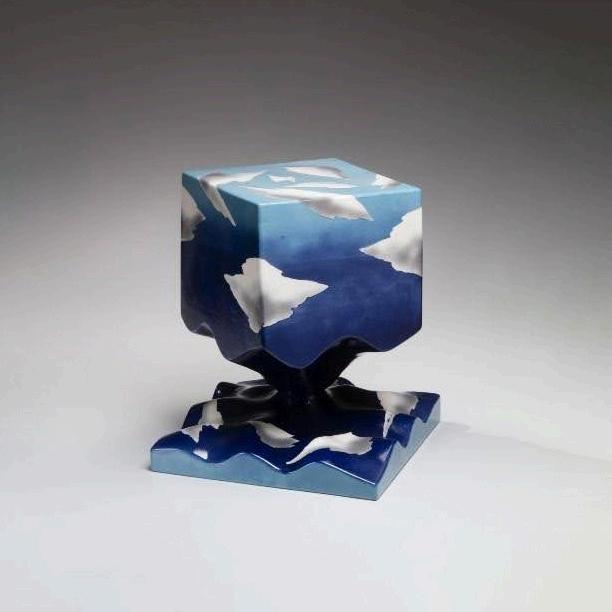
Over the course of Yanagihara’s second sojourn in the United States, he attained something of a celebrity status within the craft scene. His move from Alfred University in New York to Scripps College in California in the autumn of 1973 was reported in a volume of Craft Horizons, the magazine of the American Craft Council (vol. 33, no. 5, p. 7). When he returned to Japan in 1974, Yanagihara again chose to remain independent rather than join any association. Although affiliation with an association would have brought material support, patronage, and encouragement from other members, it would also have required him to follow the group’s philosophy. Remaining independent was more important to Yanagihara, as it allowed for greater imagination and freedom in his art.
Perhaps the most radical interlude of his career was the Sky (Sora 空) series which he developed in 1977 and pursued until 1981. With this series, Yanagihara further removes the seriousness from the medium ceramics and turns towards playfulness. He pursued the contradiction to make atmospheric-themed works out of heavy, solid material. Cube, disc, and balloon-like forms balance on undulating platforms, each dominated by elements colored in shades of blue and decorated with white clouds. One type of form comprises cubes that balance on a single point, and therefore emulate lightness––like clouds.
Westerlies (Henseifū 偏西風) is made up of a square panel pierced with a round hole, through which a twisting cloud seems to float. The object is today in the collection of the Museum of Modern Ceramic Art, Gifu. Like Westerlies, Yanagihara bestowed the unique objects with titles referencing wind and sky like Dynamics of the Sky (Sora no rikigaku 空の力学) or Memories of the Sky (Sora no kioku 空の記憶).
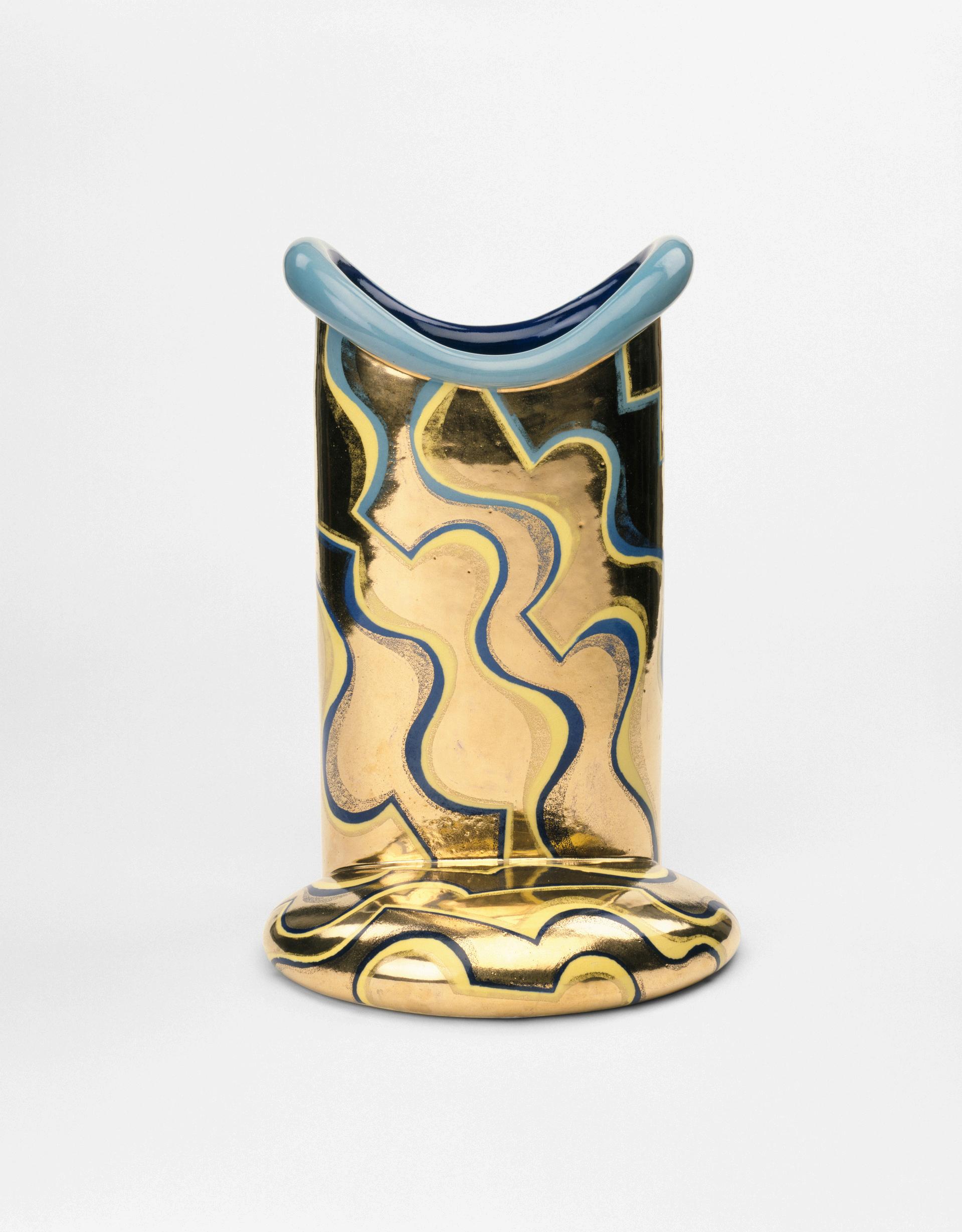
In 1984, Yanaghira became a professor at Osaka University of Arts and remained there until his retirement in 2006. In his first year at the university, he began working on a new series of playful vessels with applied luster glazes, sometimes embellished with gold and silver, harkening back to the innovative style of his teacher Tomimoto and his mantra “Don’t make pattern out of pattern” (Moyō kara moyō o tsukuru na 文様から文様をつくるな). Yanagihara continued this new pop and funk series until 1991, concentrating primarily on three types of vessels that he developed and named: cylindrical vases (tō kabin 筒花瓶), boot-shaped vases (kutsu kabin 沓花瓶), and smiling pots (shōkō-ko 笑口壺). The so-called boot-shaped vases have a cylindrical body that is attached to a round foot which protrudes to one side. The smiling pots are of inverted cone shape with an opening that is thicker on one side and hangs down like the fleshy lower lip. A vivid yellow and blue are the dominant colors in this series and are applied in patterns that reflect flowing water.
Works from this series were featured in the exhibition Four Aspects of Contemporary Japanese Ceramics, organized by the Newcastle Region Art Gallery and held in nine different Australian cities from 1987 to 1989. (In this exhibition, the “smiling pots” were called “vessels with cosmic patterns”). The objects in this series were coil-built by Yanagihara from fine stoneware clay and then fired with a transparent glaze at 1260 degrees Celsius. Finally, he applied color and luster glazes and low-fired each object several times at 670 degrees Celsius.
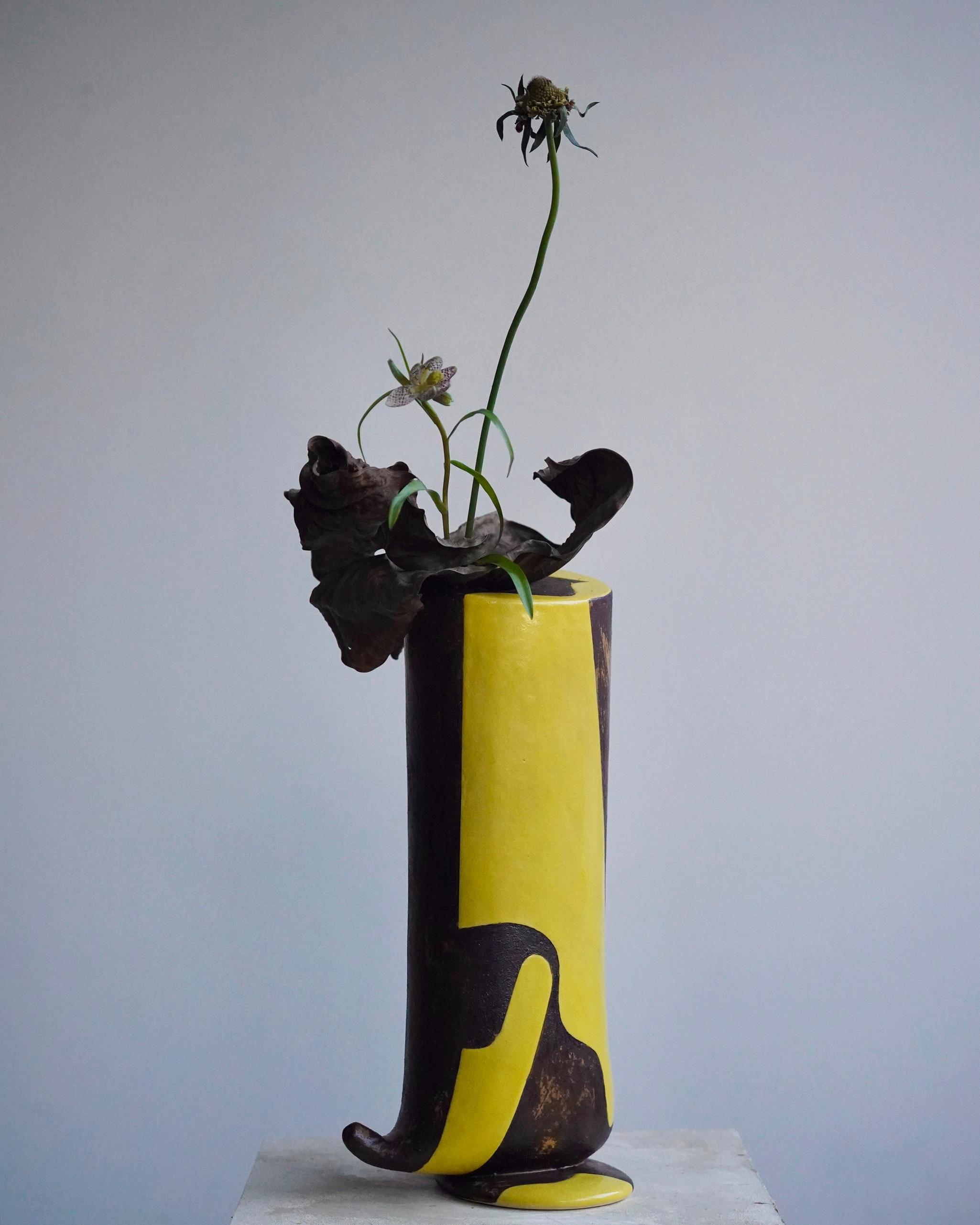
In parallel, Yanagihara began working on another series that he identified as Oribe, referring to the type of ware that developed around 1600 in the vicinity of Kyoto, where his studio was located. Typical of Oribe ware are asymmetrical or distorted shapes and a combination of stylized drawings and copper-green glaze, as well as black or red tones. Most of his new Oribe works are a combination of yellow, black, and silver, with the occasional addition of orange. From around 1992, he sometimes substituted yellow with blue, eventually abandoning yellow entirely after 1997. The patterns achieved after this are more geometric and less fluid than in the previous series, with clear boundaries achieved through the use of masking tape when applying the color.
Yanagihara remained true to his emphasis on “play,” and in 1992 he conceived a new shape of vessel that he described as Flower-eating (kashoku 花喰). Positioned on a thin, triangular-shaped foot is a turnip-shaped form with a swollen belly and a round opening resembling a mouth. Since the tops are flat and closed, the “mouth” is where the flowers would need to be placed. Around 1994–1995, he introduced another form that he called the Retroflex Vessel (kōkutsu-hei 後屈瓶): an elevated upper section in the shape of a cylinder with an opening for flowers is lifted by a flexed leg, lending the vessel a dynamic presence. In 1997 came the celebrated Licking-up Vessel (perotto-hei ペロット瓶), which resembles an insect with a long snout.
In the latter half of the decade, Yanagihara reduced his use of color. He returned to utilizing silver but employed a dull, matte finish instead of the mirror-like shine characteristic of his 1970s artworks. Set against black tones, the silver color appears tarnished as if it has aged. Set against black tones, the silver appears tarnished, as if aged. In 2000, he used this Silver Oribe (gin-oribe 銀オリベ) in a new series of works that sought to evoke the decorativeness of Jōmon-period (ca. 14th–3rd century BC) pottery and the simple forms of Yayoi-period (3rd century BC–3rd century CE) pottery. The expansive curved edges, coupled with spiraling motifs, alongside meticulously crafted interior designs, lead the viewer’s eye into the vessels’ interior.
In his mid-60s, Yanagihara received accolade after accolade for his achievements. He was awarded the Kyoto City Art Contribution Prize in 1998, the Kyoto Prefecture Prize for Cultural Contribution in 2000, the Japan Ceramic Society Prize in 2003, and the Kyoto Art Culture Prize in 2005. After retiring from Osaka University of Arts in 2006, Yanagihara remains active and full of vigor, and has embarked up on multiple new series, such as Anti-Vessel (han-ki 反器) in 2004, Well (ido 井戸) in 2007, Topological Standing Pots (toporo-ritsu tsubo トポロ立壷) in the second half of the 2010s, and Exhalation and Inhalation (Koki kyūki 呼気・吸気) in the 2020s.
In his 80s–– and now in his 90s–– Yanagihara has concentrated on creating single-footed creature-like objects with round, swollen bodies and organic, uneven openings. He remained true to his idea of creating unique shapes and achieving a symbiosis of an abstract sculpture and functional vessel against the dichotomy of their natures. Throughout his artistic life, Yanagihara has been devoted to playfulness and stayed true to the fusion of form and decoration.
The author, Dr. Andreas Marks is the Mary Griggs Burke Curator of Japanese and Korean Art and Director of the Clark Center at the Minneapolis Institute of Art.
To learn more about this exhibition and Yanagihara Mutsuo's work, visit www.daiichiarts.com

